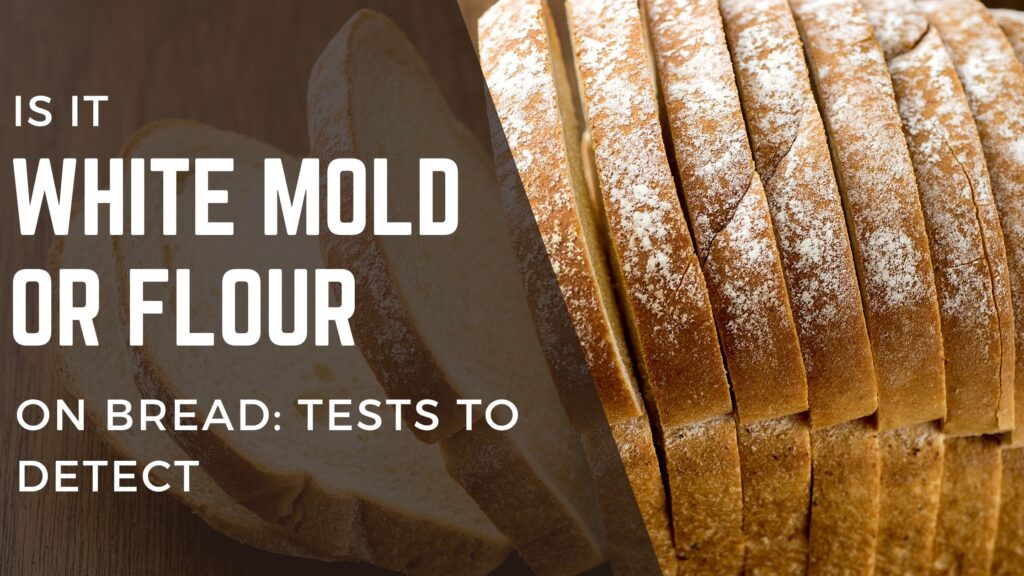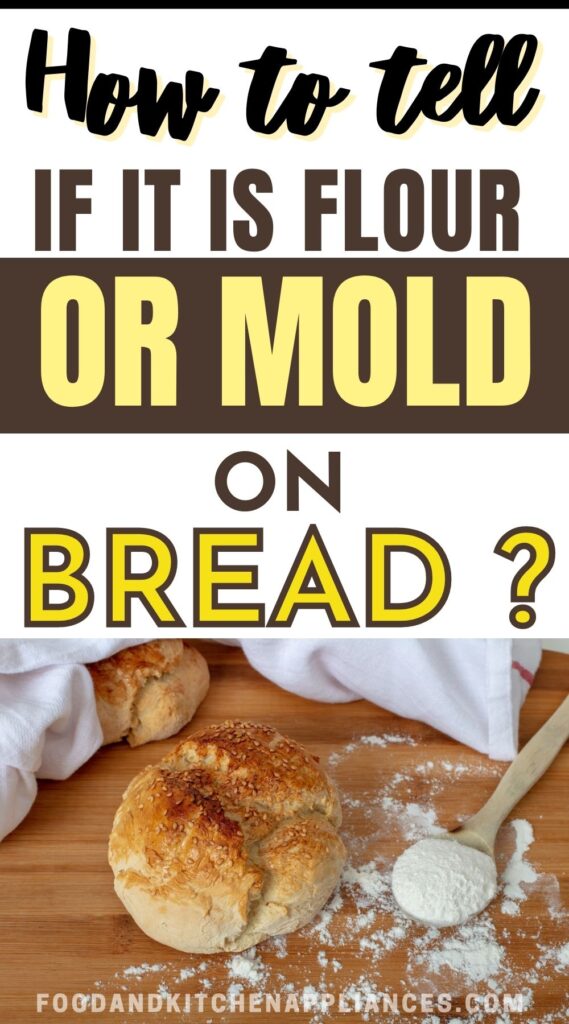If you’ve ever opened a loaf of bread and noticed a strange white substance on the surface. You may wonder if it is white mold or flour on bread. This is a common problem for bread products, and various factors, including moisture, temperature, and storage conditions, can cause it.
Fortunately, several tests can be used to detect the presence of white mold or flour in bread. These tests typically involve examining the product for visible signs of mold growth, such as discoloration or fuzzy patches.
Additionally, laboratory tests can be used to confirm the presence of mold and identify the specific type of mold. By detecting mold early, you can take steps to prevent it from spreading and potentially contaminating other products in your kitchen.

What is White Mold on Bread or Flour?
If you’ve ever opened a loaf of bread and noticed a white, fuzzy substance, you may be dealing with white mold. This type of mold is a common problem in food products, and various factors can cause it.
Causes of White Mold on Bread
White mold on bread or flour is typically caused by a fungus called Rhizopus stolonifer. This fungus thrives in warm, moist environments, often found on bread and flour in humid conditions. Other factors that can contribute to the growth of white mold include:
- Contaminated equipment or surfaces
- Poor sanitation practices
- Improper storage conditions
- Exposure to moisture or humidity
Health Risks of White Mold on Bread or Flour
While white mold on bread or flour may not pose a severe health risk to most people, it can harm those with weakened immune systems.
Sometimes, moldy bread or flour can lead to allergic reactions or respiratory problems. Also, mold can produce mycotoxins, toxic substances that can cause various health problems.
To avoid the health risks associated with white mold on bread or flour, it’s essential to prevent its growth. This may include storing bread and flour in a cool, dry place, using clean equipment and surfaces, and practicing good sanitation. If you do encounter white mold on your bread or flour, it’s best to discard it and avoid consuming it.
Tests to Detect White Mold on Bread or Flour
If you suspect that your bread or flour has white mold, there are several tests you can perform to confirm your suspicions.
Visual Inspection
The most obvious way to detect white mold is by visually inspecting your bread or flour. Look for any white or gray spots or patches that appear fuzzy or powdery. If you see any of these, it may be a sign of white mold.
Scrap with your finger test
If you see any white spot on your bread, scrap it with your finger. If it feels like powder, it is flour. If the spot comes out as a little piece, not powder, it is mold.
Mold has a smooth surface and is not like powder. You can for sure say that it is mold, not flour.
Smell Test
White mold has a distinct musty smell. If you suspect your bread or flour has white mold, whiff. If you detect a musty odor, it may be a sign of white mold.
Touch Test
You can perform a touch test if you suspect your bread or flour has white mold. Gently touch the surface of the bread or flour with your finger. It may signify white mold if it feels slimy or sticky.

Prevention of White Mold on Bread or Flour
White mold on bread or flour can be prevented by taking a few simple measures. Here are some ways to prevent white mold from growing on your bread or flour:
1. Keep your bread and flour in a cool, dry place
White mold thrives in warm, moist environments. Keeping your bread in a cool, dry place will help prevent mold growth. Store your bread in a bread box or a sealed container, and store your flour in an airtight container.
2. Use fresh ingredients
Fresh ingredients will help prevent white mold from growing on your bread or flour. Ensure your flour is fresh and your bread ingredients are not past their expiration date.
3. Clean your storage containers
Ensure your storage containers are clean and dry before storing your bread. Clean your containers with mildew thoroughly with water and vinegar.
4. Use a dehumidifier
If you live in a humid climate, using a dehumidifier can help prevent mold growth on your bread or flour. A dehumidifier will remove excess moisture from the air, making it less hospitable for mold.
5. Check your bread and flour regularly.
Check your bread and flour regularly for signs of mold. If you see any mold, discard the affected food immediately. Ensure to also check the surrounding area for any signs of mold growth.
These prevention measures can help prevent white mold from growing on your bread or flour.
What is the difference between white mold and green mold bread?
Knowing the difference between white and green mold is essential if you are dealing with mold on bread or flour. Here are some key points to help you distinguish between the two:
Appearance
White mold usually appears as a powdery, fluffy substance on the surface of bread or flour. It can also have a fuzzy or cottony texture. In contrast, green mold is often slimy and darker, greenish.
Growth
White mold grows in cool, damp environments and can spread quickly if left untreated. On the other hand, green mold thrives in warm, moist conditions and can take longer to develop.
Health Risks
Both white and green mold can pose health risks if ingested. However, certain types of green mold, such as Aspergillus, can produce mycotoxins that can cause serious health problems.
Therefore, taking proper precautions when dealing with mold on bread or flour is crucial.
Prevention
To prevent mold growth on bread or flour, keeping them in a cool, dry place is essential. You can also use airtight containers to reduce the risk of exposure to moisture.
Additionally, it is crucial to inspect your bread or flour regularly and discard any items that show signs of mold growth.
White and green mold are two different types of mold that can grow on bread. Knowing the differences between the two can help you take the necessary steps to prevent mold growth and protect your health.
What Causes White Spots on Bread?
When you see white spots on bread, it is most likely due to the growth of a fungus known as white mold. This mold thrives in warm, humid conditions and can be found in many foods, including bread and flour.
It is caused by a fungus known as Sclerotinia Sclerotiorum. This fungus produces a white, fluffy growth on the surface of bread or flour, which can quickly spread and cover the entire surface. The growth of white mold on bread can be caused by several factors, including:
- Moisture: White mold thrives in warm, humid conditions, so if your bread is stored in a damp environment, it is more likely to develop mold.
- Poor ventilation: If your bread is stored in an airtight container, it can create a humid environment perfect for mold growth.
- Contamination: If your bread or flour has come into contact with mold spores, it is more likely to develop mold.
It is important to note that white mold is not harmful to humans in small quantities but can cause allergic reactions in some people. If you have a mold allergy, avoiding consuming any food with mold is best.
To prevent the growth of white mold on your bread, storing them in a cool, dry place with good ventilation is essential. You should also avoid storing bread or flour in airtight containers, which can create a humid environment ideal for mold growth.
If you do notice white spots on your bread or flour, it is best to discard them and purchase a fresh batch. Mold can spread quickly and easily, so it is essential to take precautions to prevent its growth in your food.

Why is There Flour on My Bread?
You may notice a powder white substance on the surface when you buy bread from the store. This substance is usually flour, and it is added to the bread during the manufacturing process.
The purpose of adding flour is to prevent the bread from sticking to the baking surface. It also helps to give the bread a nice texture and appearance. Flour is also used to dust the surface of the dough during the shaping process.
Sometimes, you may notice more flour on your bread than usual. This could be due to a few reasons:
- The bread was not adequately shaped, causing excess flour to remain on the surface.
- The bread was not adequately cooked, causing excess flour to remain on the surface.
- The bread was not properly packaged, causing excess flour to stick to the surface.
It is important to note that excess flour on bread is not harmful. However, it can be unsightly and may affect the taste and texture of the bread.
If you are concerned about the flour on your bread, try wiping it off with a clean, dry cloth. Alternatively, you can buy bread with less flour on the surface.
10 minutes kitchen cleaning routine